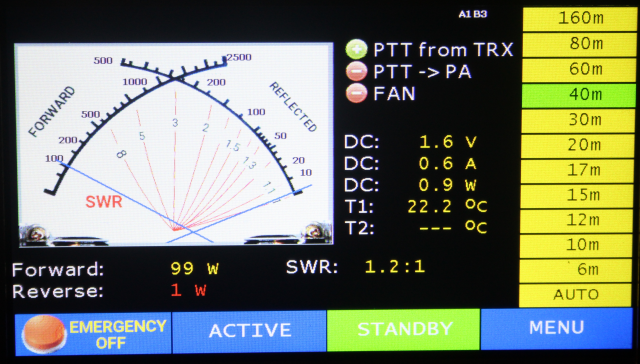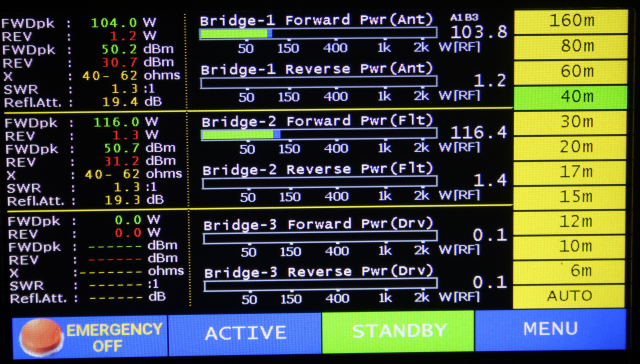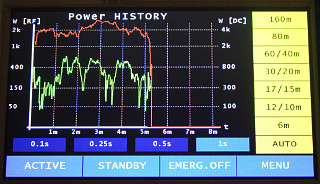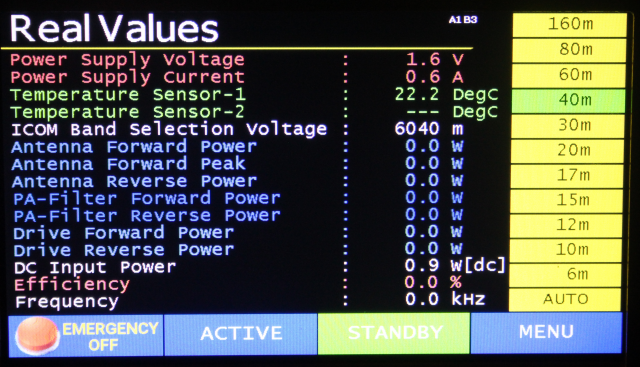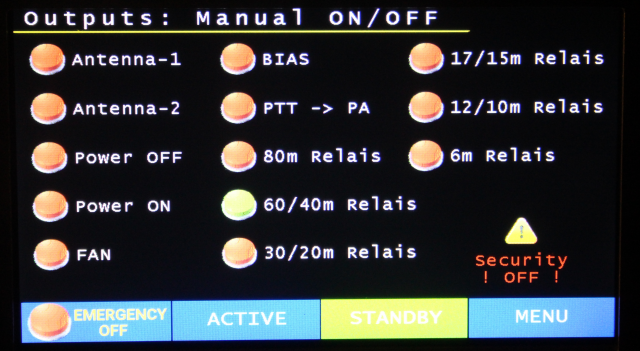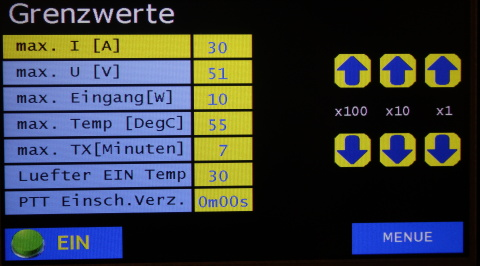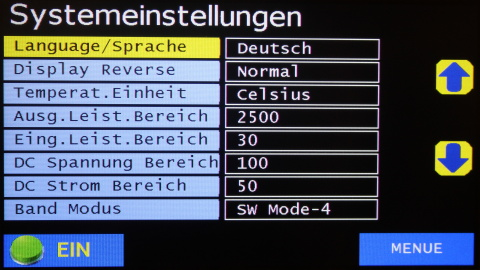Sidebar
Table of Contents
DSP-7-PA
Controller for amateur radio power amplifiers with large 7" TFT touch color display
and many measurement functions, sensors and WiFi webinterface
User manual Firmware 1.4
When DSP-7 is turned on, a welcome screen appears and all functions are turned off and disabled (except fan control if the cooler is already hot). If a power relay is used, the power amplifier supply voltage is also turned off. The only control available is the ON key. Touching the ON button turns on the PA supply and the controller is in standby mode. (The photos shown here show DSP-7 in English mode, in the system menu you can switch to German, everything will then be displayed in German language).
Operating modes:
Standby: The power supply is switched on. The transceiver is directly connected to the antenna, the amplifier is inactive and pressing the PTT has no effect.
Active: The controller is waiting for PTT. When PTT is pressed, the RX / TX relay switches to TX and the amplifier is in operation.
NOT-OFF: When the OFF button is pressed or an emergency situation occurs, the controller goes into emergency OFF mode and everything is turned off. Correct the error situation and press ON to reactivate the system.
When the ON button is pressed after power up, the controller will display the screen with the large bars. Now touch the “MENUE” button to enter the selection menu:
Here you can navigate to all functions and screens of the DSP-7 controller.
Buttons at the bottom of the screen:
- EMERGENCY: switches everything off.
- ACTIVE: Switches to active mode, the amplifier can be used normally.
- STANDBY: switches to standby mode, the amplifier is in standby mode but does not respond to PTT. The transmitter is directly connected to the antenna.
- MENU: Displays the main selection screen.
Buttons on the right side:
The band select buttons are used to switch to a band. This automatically selects the appropriate low pass filter and antenna (if an antenna switch is present). The AUTO key can be used if an ICOM transceiver is connected via the CI / V interface or via the BAND line.
The assignment of antennas to bands is done in the antenna screen as described below.
The assignment of low-pass filter banks to bands is done in the SYSTEM menu and is described there.
Status line below:
It shows the active antenna if an antenna switch is used and if the antenna menu is set up.
Then it shows the active low pass filter bank. DSP-7 supports 7 filter banks that can be used by multiple bands.
When an Icom transceiver is connected to the CI-V interface, the frequency and CIV address are displayed. If the transceiver selector is used, which of the (up to) 4 transceivers is used is displayed.
Overview:
This screen shows the most important operational data.
As with any other screen, the bar shows the average power value and the number shows the maximum value. The bar has a blue marker which also shows the peak value.
Large bar:
Photorealistic SWR meter:
shows power and SWR in a photorealistic simulation of an analog cross pointer meter as well as some other measurements.
Measurement bridges:
gives a complete overview of all three power / SWR couplers as well as some calculated values like reflection loss and others.
HISTORY:
Raw data:
This screen displays the raw values measured by the on-board AD converter. This data is very useful for installation and debugging purposes.
Real values:
This screen shows the values of the AD converters, but (unlike the previous screen) the real values are calculated from the raw values.
STATUS:
This screen shows the status of the various digital inputs and outputs. It is very useful when setting up the amplifier. For example, you can see if relays are energized or not, a very important screen.
Manual switching:
In this screen you can switch the outputs manually. Note: When this screen is open, the automatic safety functions are disabled. Use this only for testing purposes during setup and maintenance of the amplifier.
ANTENARY:
This screen allows you to assign bands to the antennas. The controller has two antenna outputs for two relays. With these two relays we can connect up to three antennas to the amplifier. The schematic on the screen shows the state of these relays. Select an antenna ANT-1 to 3 and then enable or disable the bands for that antenna.
Limits:
these are the limits of the safety functions:
- max I [A] … If this current is exceeded, the controller goes into the emergency stop state. I also recommend the use of the safety switch.
- max. U [V] … If this voltage is exceeded, the controller goes into the emergency stop state.
- max. Temp … If this temperature is exceeded by one of the two temperature sensors, the controller goes into the emergency stop state.
- max TX [min] … The controller goes into the emergency stop state if it is keyed on for longer than this time.
- FAN ON temp … When one of the temperature sensors exceeds this temperature, the FAN output is turned on. It will be turned off when the temperature is 4 degrees lower than this value.
- PTT Delay [ms] … The amplifier clock is delayed by this time in milliseconds. This delay can be used to turn on the MOSFET bias (BIAS) first and then activate the PTT.
- max. drive [W] … When this control power is exceeded, the device switches to the emergency stop state (an input power - jumper must be installed for this function).
CALIBRATION of the measuring bridges:
the calibration of the measuring bridges is described on a separate page.
TOUCHCAL:
This screen is used to calibrate the touch sensor of the 7“ display. Use a ballpoint pen with the lead retracted to touch the screen during calibration. This will give much better results than using your finger.
SYSTEM MENU 1:
This screen has several system settings:
- Language … DSP-7 contains English and German language. Please contact me if you need another language, the firmware can any Latin language if someone helps with the translation.
- Display Reverse … rotates the display 180 degrees. The contrast and readability of the 7 “display is different from the top or bottom. It is possible to mount the DSP-7 upside down and then flip the display with this setting.
- Temperature. Units … select Celsius or Fahrenheit. The temperature settings in the limits screen also use this unit.
- DC Voltage Range … this controller has a wide voltage range. In addition to this setting, a voltage divider must be connected to the Um input. See the connection description for details.
- DC Current Range … this controller has a wide current range. In addition to this setting, the shunt resistor can be modified. Details can be found in the connection description and shunt settings (see below).
- Bands Mode … provides various band ↔ filter bank combinations as described below.
- RF Power Range … this controller has a wide RF power range. The power / SWR coupler must of course be suitable for the required power. The only requirement is that the coupler produces a forward / reverse voltage between 0 and 2.4 volts over the entire range.
- Drive Pwr Range … the range for measuring control power if an input SWR coupler is installed.
- Shunt [mohms] … Value of shunt resistor used for current measurement.
Assignment of bands to filter banks:
This controller has 6 outputs to switch up to 7 filter banks (Bank-1 is selected when no relay is activated). Four different band → filter bank configurations are available for shortwave amplifiers. Select this configuration as follows:
| filterbank relay | SW Mode-1 | SW Mode-2 | SW Mode-3 | SW Mode-4 |
| no | 160m | 160m | 160m | 160m |
| 1 | 80m | 80+60m | 80m | 80+60+40m |
| 2 | 60+40m | 40+30m | 60+40m | 30m |
| 3 | 30+20m | 20+17m | 30m | 20m |
| 4 | 17+15m | 15m | 20+17+15m | 17+15m |
| 5 | 12+10m | 12+10m | 12+10m | 12+10m |
| 6 | 6m | 6m | 6m |
Example: When SW Mode-1 is selected and you switch to the 30m band, relay output 3 is activated.
SYSTEM MENU 2:
here are more system settings:
- Aux Input Mode: there are four input lines that have alternative functions. Look in the connector manual and search for “BAND ROT SWITCH, Alternate Functions”. These connections can be used as an input for a rotary switch to select the filter bank. Or alternatively, they can be used as an additional 4 PTT inputs (required if the automatic transceiver selector is used).
- CI-V Addr.1 deflt: This is the default CI-V address when connecting a single Icom transceiver. Set this value to the CI-V address of the transceiver. The baud rate is 4800 Bd.
- CI-V Addr.2 … 4: These additional CI-V addresses are used when the aux input mode is set to “PTT 4 input”. By connecting the alternate inputs to the PTTs of up to 4 Icom transceivers, DSP-7 automatically uses the CI-V address of the currently active transceiver (required when using the automatic transceiver selector).
- System Mode: DSP-7 can be used for two different applications. 1) as a power amplifier controller or 2) as a display for a triple power / SWR meter. While the basic functions of the DSP-7 are the same in both modes, the display shows different controls optimized for these modes.





